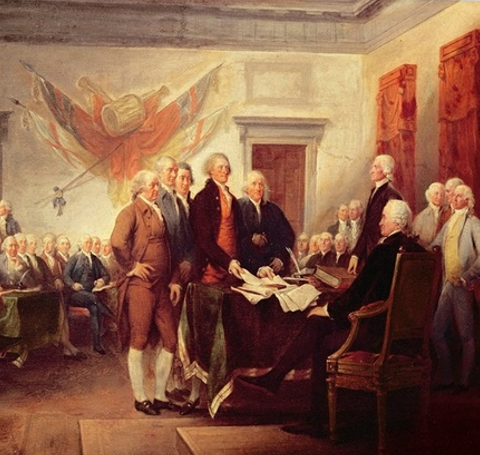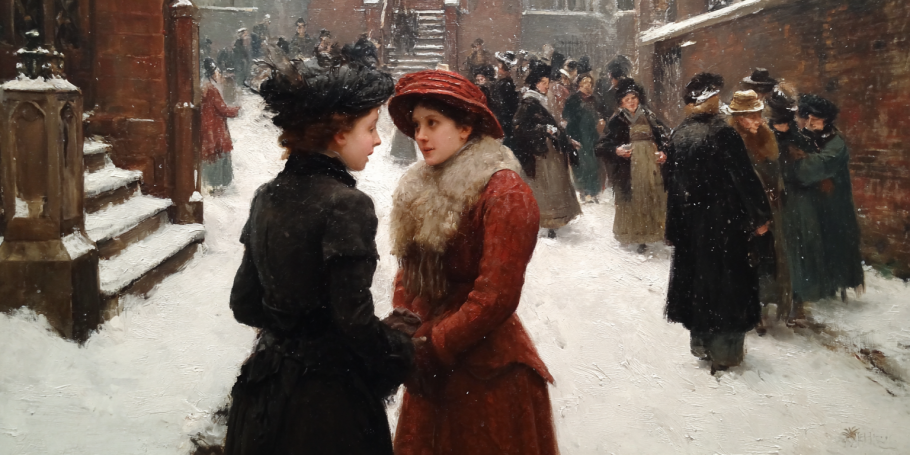I appreciate Alan Hurst’s thoughtful rejoinder to my parents’ recent book, All Things New. I have found a lot of common ground as I’ve read and reread his trio of essays. In fact, the more we converse about the book and his critique of it, the harder it gets for me to write this essay because I find more and more common ground. And yet, there remain important differences in emphasis, some instances where Alan on the one hand and Terryl and Fiona on the other are talking past each other, and some areas of subtle but substantive disagreement. These are what I hope to highlight in this piece.
In his first essay, Alan tackles what he sees as an implied “either/or” between woundedness (which is emphasized in All Things New) and sin or guilt (which he wishes to stress). I understand where he’s coming from in this regard. The subheading for the relevant chapter in All Things New is “from sin to woundedness” which certainly suggests leaving one behind for the other, as do other examples in the text. However, an explicit disclaimer in the book also rejects the either/or position and advances the same both/and position Alan defends. In that same chapter, Terryl and Fiona write that “none of this is to say that we are not capable of sin in the sense of deliberately chosen action that is wrong and harmful. We clearly are.”
So, although I found Alan’s discussion of the natural man compelling and persuasive, the primary issue here seems to be less either/or vs. both/and (since Alan and Terryl and Fiona are all in the both/and camp) and more a matter of emphasis. There’s what is true, and then there’s what is true and helpful.
I relate to this on a personal level. As a young child of 7 or 8 years old, I suffered from guilt-fueled, repetitive religious compulsions. Every night for a certain period of my childhood, I went through the same pattern. First, I knelt down by my bed to say my night-time prayers. Second, I got into bed and started to drift off. Third, I was seized with guilt that my prayer had not been good enough. Had I let weariness curtail my prayer? Had I skimped on my list of things to be grateful for? Were there people I could have prayed for by name, but hadn’t? If something happened to them, wouldn’t it then be my fault? Fourth, I wrestled against these feelings of guilt and inadequacy, trying to rationalize that my prayer had been good enough. Fifth, I inevitably lost this battle of rationalization, climbed back out of bed, knelt down, and began to pray again. The cycle repeated multiple times every night until I was reduced to an exhausted, desperate wreck, sobbing quietly on my knees by the side of my bed, completely overwhelmed by self-recrimination for my total inability to say a perfect prayer.
I have still never said a perfect prayer. I’ve never done a perfect thing in my life. But I was lucky enough to escape from this dark place more or less on my own. By the time I was 12 or 13, I recognized myself immediately in the depiction of a woman who obsessively traced woodgrains on a floor as a form of religious compulsion in Orson Scott Card’s Xenocide. That had been me, but by the time I read the book, it wasn’t me anymore.
The route to my escape was simple reasoning. Surely a kind, wise Heavenly Father would have better ways of tutoring His children. Therefore the feelings of crippling guilt—as opposed to the ordinary, well-deserved variety I was also familiar with—must come from some other source. Satan? My own defective mind? It didn’t matter. I set my jaw, did my best to do a good job on the one prayer I allowed myself per night, and then refused to get out of bed. The voice calling me wasn’t God’s, and I wasn’t going to heed it.
As a result, I’m no longer in the target audience for All Things New. I fall much closer to Alan in my theological leanings and emphasis. Nevertheless, the memories of these childhood struggles with scrupulosity, or “pathological guilt/anxiety about moral or religious issues,” give me a window into the struggles that particular audience and subset of believers face. I no longer doubt that Christ’s grace is sufficient to save even a wretch like me, which significantly lightens the burden of being a wretch.
That’s not to say I think that he’s wrong. On the contrary, I know that at least in my case the emphasis on guilt was strongly tied to my own pride. The only reason for me to be so gobsmacked by evidence of personal imperfection is if that evidence contradicts an absurdly high overestimation of my own goodness. Pride goeth indeed before the fall. As a secondary consideration, there’s a definite arrogance in telling God you know better than Him who He should love and treat kindly.
So it’s not that I think Alan’s diagnosis is wrong. He hit the nail on the head, at least in my case. But being right isn’t always the same thing as being helpful, and what his argument has going for it in terms of accuracy it may lack in terms of pastoral efficacy. Just think about someone having a panic attack. It’s true that they’re irrationally overreacting, but telling them so is not the best approach to helping them out of the situation. There’s what is true, and then there’s what is true and helpful.
Unfortunately, I also find that Alan indulges in excesses like those he critiques. For instance, it is simply not the case that all forms of eating are a variety of lethal violence. The whole point of fruit is to entice organisms to eat and subsequently spread the seeds within. That’s not robbing plants; it’s doing them a favor. And what about husbanding bees for their honey, cows for their milk, or chickens for their eggs? Couldn’t one at least argue that’s a form of cooperative exchange or symbiosis rather than naked exploitation? Yuval Harari went even farther, declaring in Sapiens that “these plants [wheat] domesticated homo sapiens rather than vice versa.” Is Alan right that eating bread depends on the mass murder of wheat, or is Hariri right that wheat has enslaved the entire human race? You can look at it either way, I suppose, but at the end of the day I would question any framework that characterizes enjoying a peanut butter and jelly sandwich with words like “killing,” “scorched corpses,” and “victims.”
Similarly, I don’t believe “humility is liberating” would have been a useful message for someone to whisper in my ear when I was a 7-year-old boy with a tear-streaked face falling asleep on my knees by the bed. I don’t see it helping me very much as a 19-year-old missionary wandering in circles around my first apartment at night hitting myself over and over and hissing “Worthless. Worthless. Worthless,” in an endless litany. My trainer gave me a hug, which was decidedly more effective.
Then I get to the last two paragraphs of Alan’s first piece and I want to stand up and cheer. Now he’s speaking my language! I have come a long way since I was 7 years old, or since I was 19. I have learned the “humility is liberating” message (although I still struggle with the application). And I love both his assertion that “It is all me, I own it all” and—even more—his declaration that “although I own it all, I do not own myself.”
That’s where I’ve arrived myself as well. I no longer doubt that Christ’s grace is sufficient to save even a wretch like me, which significantly lightens the burden of being a wretch. And yet, it has been a long process to get there, which is what Alan’s response seems to underestimate. By countering the woundedness emphasis with an even more extreme wretchedness emphasis, his rejoinder seems to focus exclusively on the lessons I was only ready for in my 20s and 30s, without adequate attention to the formative and difficult lessons I had to learn first at 7 and 19. And to me, that feels a little like kicking away the very ladder that I used to get where I am before others have a chance to climb it.
In his second piece, Alan tackles the critique of retributive justice in All Things New. This is where it seems to me that Alan and Terryl and Fiona are talking past each other. My own entry point into the discussion starts with Alma’s teachings to his son Corianton where his depiction of justice is thoroughly karmic. He teaches his son that “the meaning of the word restoration is to bring back again evil for evil, or carnal for carnal, or devilish for devilish—good for that which is good; righteous for that which is righteous; just for that which is just; merciful for that which is merciful.” He concludes that “that which ye do send out shall return unto you again, and be restored.” For him, justice is what you get when the larger principle of restoration operates in the absence of mercy afforded by the atonement. You always get what you send out (restoration is unavoidable) and without the intervention of Christ, there’s no recourse for all that evil we inevitably send out. What goes around comes around.
Most of Alan’s second piece is a defense of this karmic form of justice: the punishment must fit the crime. I strongly agree with it. But is it a rebuttal to Terryl and Fiona’s critique of “retributive justice”? Not necessarily. The core of their critique of retributive notions of justice seems to be about the why rather than the what. Alan cites my parents as saying retributive justice “often conceals a human thirst for redemption,” but notions of “thirst” are orthogonal to debates about proportionality or fairness and speak only to motive, and specifically a motive to hurt.
To me, it seems All Things New is taking aim at one extreme position: namely, a tyrannical God who indulges in revenge with malicious intent. This is strengthened by some of the descriptions from the book’s Introduction about Latter-day Saints laboring under precisely that glowering threat. Extreme the position may be, clearly some people hold it, and are injured thereby. Meanwhile, Alan is taking aim at an opposite extreme: namely, a non-judgmental God who never exacts justice at all. Alan’s extreme is just as real and injurious in practice and generally goes under the term Moral Therapeutic Deism. Although both of these extremes warrant a response, it shouldn’t be the case that a response to one is confused with a tacit endorsement of the other.
What’s more, the truly complicated difficulties lie not at either of these extremes, but in the middle. How do we reconcile a loving God with the explicit references to anger and wrath in the scripture, not to mention the depiction of Christ burying, burning, or drowning entire cities? And how do we approach the tensions of this seeming paradox in light of Alma’s karmic notions of justice where it seems that the consequences of sin are less like a penalty imposed at a judge’s discretion and more like the natural consequence of evil? These are the questions that most intrigue me, but we’ll need to step away from the extremes to conduct that investigation.
This provides a nice segue into Alan’s third piece, where we take up the question of how we are to relate to our open canon of scripture. The fundamental thesis of All Things New is that our Latter-day Saint culture is far more burdened than we realize with the debris of the apostasy, starting with Augustine and continuing on through prominent figures of the Reformation such as Martin Luther and John Calvin. As Alan summarizes the case:
The Restoration was supposed to heal the souls this false Augustinian story had wounded—in fact, the Givenses suggest, Joseph Smith’s attacks on creeds were aimed at Augustine-inspired Protestant creeds like Augsburg and Westminster and not at the Nicene Creed as Latter-day Saints often imagine.
This thesis is the most important one in the book. My chief complaint with Alan’s rejoinder is that he spends more time addressing the corollaries of this thesis and not enough time addressing—either favorably or disfavorably—the thesis itself.
So, for example, Terryl and Fiona cite the Chicago Statement on Biblical Inerrancy stating that “Scripture is without error or fault in all its teaching” and that “the whole of Scripture and all its parts, down to the very words of the original, were given by divine inspiration.” In other words, the Old and New Testaments are word-for-word perfect. Terryl and Fiona then make two observations about Latter-day Saint approaches to scripture. The first is that, culturally, we tend to act as if we were scriptural inerrantists and the second is that this tendency flies in the face of the whole Restoration project. Not only does the Book of Mormon discuss its own errors and those of the Bible, but Latter-day Saint leaders like Joseph Smith, Brigham Young, and George Q. Cannon (all cited in All Things New) propound a view of scripture and revelation that is incompatible with the Chicago Statement.
Alan essentially passes all this by in his review, more or less without comment. Instead, what he challenges is the remedy proposed by Terryl and Fiona. They cite C. S. Lewis’s view that in any conflict between “the doctrine of the goodness of God [and] that of the inerrancy of Scriptures” it is the goodness of God that “is the more certain of the two.” This strikes Alan as too hasty in its willingness to cast off scripture that offends our preconceptions, and that is the approach he rejects.
This gives the unfortunate and mistaken impression that Alan is defending inerrantism. Terryl and Fiona have identified a problem and proposed a solution. Alan has rejected the proposed solution without proferring an alternative or sufficiently addressing the underlying problem. I say this impression is mistaken because I’ve had an opportunity to discuss this with Alan, and so—based on conversation outside his essay—I no longer consider his position inerrantist. But it is what I took from the essay. Humans can always mess up anything. It’s our superpower.
Consider Judges 11 and the story of Jephthah, which Terryl and Fiona call out as an egregious example of the conflict between God’s love and the text. They do not explicitly say so, but I can see why a reader would view their treatment as rejection. The story causes us problems, so get rid of it.
Alan takes up the same story in his response and provides an example of reinterpretation. Instead of just chucking the story, might there be ways for us to reconsider what it is actually saying? He points out, for example, that God never shows up to validate or accept Jephthah’s rash promise and even cites an interpretation where Jephthah sacrifices his daughter by giving her up for religious service rather than literal human sacrifice. Alan is exemplifying a reinterpretation approach.
A key difference between rejection and reinterpretation is that rejection distances us from the scripture and reinterpretation draws us deeper in. That call to deeper engagement with the scripture is why I believe that—had they delved into the topic in greater detail—it would have been apparent that Terryl and Fiona were actually inclined towards reinterpretation rather than rejection.
I deduce this from the pages that follow, where Terryl and Fiona emphasize more work on our part, stating that “bearing the cross of discipleship involves the strenuous effort of the mind, as well as that of the body and the heart,” and then citing B. H. Roberts:
Mental laziness is the vice of men, especially with reference to divine things. Men seem to think that because inspiration and revelation are factors in connection with the things of God, therefore the pain and stress of mental effort are not required; that by some means these elements act somewhat as Elijah’s ravens and feed us without effort on our part. … “Why then should man strive and trouble himself to understand? Much study is still a weariness of the flesh.” So men reason; and just now it is much in fashion to laud “the simple faith;” which is content to believe without understanding, or even without much effort to understand.
None of this painstaking effort is required by or even compatible with a lazy approach to just throw away whatever troubles us in the scriptures, which I believe is the perception that Alan took away from All Things New. (Just as, prior to conversing with him, I read his essay as a flat-out defense of inerrantism.)
My own view is that the whole conversation around inerrantism can be a red herring. There’s a sense in which the perfection or lack of perfection in scripture is quite beside the point. How so?
The reality is that human beings never have direct, unmediated access to the world around us. This is true of something as simple as vision. The world we see is the result of a dizzyingly complex system of visual perception that is constantly making inferences and hypotheses about the world and presenting the results of this ongoing, creative, biased process to us as if it were just “the world.” But it’s not “the world.” It’s the world as processed through our visual system. This is why optical illusions exist: because the various subroutines running in our visual system are prone to error and deception.
The same is true of texts. Suppose for a moment that the King James Version of the Bible (used by Latter-day Saints) was a word-for-word transcript dictated by God himself. Were that true—the strongest possible inerrantism imaginable—it wouldn’t matter nearly as much as one might at first think. Because we would then have to read that text and the act of reading—like the act of visual perception—contaminates the raw data with our assumptions, presuppositions, and biases.
The real danger of scriptural inerrancy is not that it makes an idol out of the scriptures, but that it makes an idol out of our interpretation of the scriptures. Which, after all, is the only thing we have. And that would really just be a shorthand for making an idol out of ourselves, the interpreters. Scriptural inerrancy thus veers perilously in the direction of idolatry but it does so not because of what it says about scripture but because of what it assumes (but does not say) about us.
Alan begins this third essay with the example of the Heliand. This serves as a template for what it looks like to fall short of being scripture: “even a brief perusal … turns up flaws, from the predictable anti-Semitism to, perhaps, a slight lack of emphasis on ‘Blessed are the meek.’” Alan goes on to say that All Things New is, like the Heliand, “an incomplete and imperfect expression of the Gospel in the inevitably misleading terms and concepts of a particular culture.”
But, as we’ve just discussed, our conception of scripture must be “incomplete and imperfect” and subject to “a particular culture” because we are incomplete and imperfect and the products of our particular culture. And wouldn’t that also be true of many authors within scripture itself? Does the Genesis account not spring from a particular culture, and include terms and concepts that mislead us when we are unfamiliar with that culture? Of course it does, as do all scriptures, which is why prophets themselves often approach scripture with the best scholarship of faithful academics: as perhaps another way to overcome those cultural particularities.
Incomplete, imperfect, and culturally contingent: these are not defects that distinguish scripture from non-scripture, they’re just the universal attributes of all human-touched texts. Even so, the question remains: If the scriptures—or, even our interpretation of them—contain error then what are we to do when we encounter problematic contradictions in the text? The Canaanites are exterminated to the last in one book, but suddenly are present again in another, later book. God is love, but God is also angry and jealous and annihilates whole cities. The examples are too numerous to list. What shall we do with them? The peril of hastily discarding one side or the other of every apparent paradox is obvious.
And to reiterate, Terryl and Fiona’s recommendation is not to just set aside whatever causes problems. Their first resort is not that “scriptures are just corruptions” but that scriptures are revealed within a particular cultural and personal context. This implies not setting aside things willy-nilly, but rather a flexible and epistemically humble approach to understanding what the scriptures say, including a willingness to try and make allowances for cultural differences and personal foibles.
Once we dispense with scriptural inerrancy and accept that scriptures are incomplete, imperfect, and culturally contingent (and maybe sometimes, although this is rarer, flat out wrong), we are left with the very difficult task of figuring out what part of the canonized text is also inspired and—more commonly—how to read it. So the project Terryl and Fiona are proposing relies a lot less on snipping sections out of the scripture and much more on subjecting our naive interpretations of scripture to faithful scrutiny.
The tough realization is that there is not a guaranteed, no-risk path to understanding scripture. The text on the page has to get into our brains, and that is an active process where we inevitably impose our own assumptions, both cultural and individual. No matter where you go: there you are. Humans can always mess up anything. It’s our superpower. Just as we can’t read the scriptures without a cultural lens, we also can’t read the scriptures without imposing our own flawed human paradigms and assumptions. We’re never going to read the scriptures perfectly because we never do anything perfectly, so the inerrancy question is probably best set aside.
If we do that, then we can return to the most important thesis in All Things New: that the work of the ongoing Restoration is not done, and that at least some of the remaining labor is the difficult, error-prone work of sifting through the traditions of our fathers to separate the good from the bad. I think there is a very real dispositional gap between Alan and Terryl and Fiona on this issue, with Terryl and Fiona much more eager to leap forward and embrace this reinterpretation and Alan much more oriented on preserving the authority of the scripture as a means of strengthening unity. This is a genuine tension, not just a misunderstanding, and one that merits further exploration.
I am pleased with how that conversation is progressing thus far. I believe Alan’s critique of some of the tentative steps my parents have taken to undertake this sifting contains useful correctives and refinements. (Those steps were tentative, after all!) I also fundamentally agree with Terryl and Fiona’s project, however. Although they certainly didn’t get the answers to such huge questions right the first time—and nowhere claimed to do so—they are taking the Restoration seriously enough to take on the difficult questions. As we all should. Moving forward is always risky, but if there’s one thing the Restoration should have taught us, it’s that the Lord wants us to take that risk, even though He knows very well we will fall and need rescue when we do. My hope is that as we move forward, we will find ways to incorporate our different perspectives in a way compatible with the unity of Zion. That task is one of the great quests of the Restoration. To the extent that we are successful, even our differences—such as we’ve explored in this exchange—will only contribute to hastening the work of the ongoing Restoration.

















